|
|
Other places of interest and diverse curiosities
|
|
|
On pilgrimage to Saint-Rita It would be a crude exageration to call this church a monument because it only exists a few decades. Nevertheless it is an important place because here the holy Rita is worshiped. In the short time that the church exists it has grown to be the biggest lieu of pilgrimage in Damme. [more info]
|
||
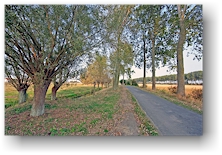 Krinkeldijk KrinkeldijkThis dike is without any doubt one of the most beautiful roads for a bicycle ride. This swirling little street, connecting Hoeke and Oostkerke, is bordered with willow trees and poplar trees. In the Middle Ages, the dike protected the land from being flooded by the sea. It most likely dates back to the 11th century. |
||
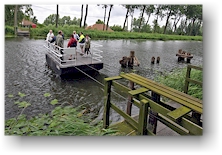 On
a ferry called "Kobus" On
a ferry called "Kobus"Transfer yourself across the canal (Damse Vaart) with Kobus. This ferry is suited for strollers and cyclists and can be found at the end of the "Moordenaarsstraatje" in Lapscheure. Have fun! |
||
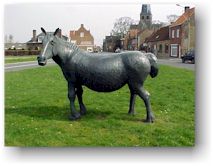 The
horse of Viven The
horse of VivenThis bronze horse is without any doubt the most famous inhabitant of Vivenkapelle. This piece of art was made by Jef Claerhout and was inaugurated in 1977, the year that Vivenkapelle became part of the community of Damme. There is nice anecdote linked to this horse. Before the merger with Damme (which was a political decision), Vivenkapelle was part of neighbouring Sint-Kruis. The horse looks melancholically to Sint-Kruis and turns his butt towards Sijsele, the political centre of Damme... |
||
|
The battle of
"het Molentje" The bloodiest page in the recent history of Damme and more particularly in the history of Moerkerke takes us back to September 1944... [more info] |
||
|
Places in Damme
that have disappeared: Monnikenrede and Sint-Katharina-Buiten-Damme All over the world, villages and hamlets have disappeared during the course of history. It is no different in Damme. The difference is that here a complete town vanished under the ground: Monnikenrede. Together with Sint-Katharina-buiten-Damme they are the most known pieces of perished cultural heritage. [more info]
|
||
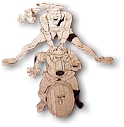 Tijl
Uilenspiegel Tijl
UilenspiegelIf there is one person who is linked inseparably to Damme, then it must be Tijl Uilenspiegel. The name Till Eulenspiegel, as a very waggish figure, is recorded for the first time in the 15th century in Germany. In the beginning of the 16th century, two editions appear regarding Uilenspiegel. In these editions, Tijl was born in Sachsen (Germany) and died in Moelln. Another edition out of the same period brings us a Tijl who doesn't like anything more than to play tricks with everybody. According to this edition, Uilenspiegel was born in Germany, but he died in Damme, where he was burried under the church tower. Shortly after that some other books are printed, also in English and French. The most known work is without any doubt the book of Charles De Coster from 1867. In this book, Tijl was born in Damme during the Spanish occupation and the religious troubles. His father, Klaas, was burnt on the pile because he helped a heretic. Tijl, his girlfriend Nele and his friend Lamme Goedzak help the Geuzen (protestant religious fighters) in their battle against the Spanish. Uilenspiegel no longer is the joker, but the people's hero who fights against the occupator. Everywhere in Damme, his spirit can be found. In one of the walls of the cemetary is a sculpture made by the artist Koos van der Kaai and besides the Damse Vaart stands a group of statues by the hand of Jef Claerhout. In Damme's Literary Museum, you can learn more about the life of this joker - hero. [more info] |

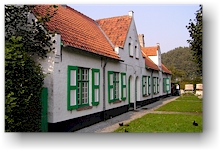 Herringmarket
(Haringmarkt)
Herringmarket
(Haringmarkt)